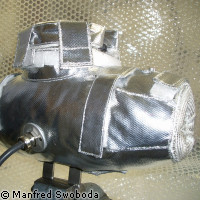Ultra-small soot particles from modern diesel engines highly toxic, study finds
A study conducted by German and Italian scientists has given rise to concerns that the particles produced by low-emission diesel engines might be more harmful to human health than those of older motors. The results of the study have recently been published online in the Environmental Science & Technology journal of the American Chemical Society (ACS). One of the reasons that the particles - which are five to 20 nanometres in diameter - are a greater threat is that they penetrate deeper into the lung due to their size. In addition, their surfaces are more reactive and hence affect the cell membranes more easily. This is a result of their structure on the one hand, which shows more defects and is similar to that of fullerene molecules, and chemical attachments on the surface, which once again increase reactivity and thus noxiousness. Compared with the exhaust fumes of older engines, which are made up of particles about twice as large, the nanoparticles have far greater toxic and inflammatory potential. In vitro tests have shown that they kill significantly more macrophage cells, which destroy microorganisms and debris in the body as an essential part of the human immune system. 'As a matter of fact, the nanoparticles emitted by a modern diesel engine kill more cells of the human immune defence than the particles of an older type of motor with produces thick black clouds that ooze out of the exhaust,' the researchers of the Fritz Haber Institute of the German Max Planck Society and the Institute of Neurobiology and Molecular Medicine in Rome, Italy, explain. 'Our findings indicate that the reduction of soot emission in terms of mass does not automatically lead to a reduction of the toxic effects toward humans when the structure and functionality of the soot is changed, and thereby the biological accessibility and inflammatory potential of soot is increased,' they add. The scientists collected soot from diesel engines, which comply with the Euro-IV emission standard. The equipment for the collection of the particles had to be specially constructed. Not an easy feat, says Dr Dangsheng Su of the Fritz Haber Institute, one of the authors of the study. While the study concentrated on utility vehicles, the results can likely also be transferred to cars, suspects Professor Robert Schlögl, director at the Fritz Haber Institute. The Euro-IV emission standard has been applied since 2005. The standard determines that diesel engines may not emit more than 50 milligrams of soot particles per kilowatt hour. In order to achieve this aim, car manufacturers have improved the combustion process in the motors, which subsequently produce fewer and smaller soot particles. 'Politics and the industry have focussed too much on reducing soot emission rates,' comments Professor Robert Schlögl, director at the Fritz Haber Institute. 'In this, however, they missed the fact that modern combustion technology generates a very different kind of soot particle, which is even more dangerous to health than old motors. Now, everything depends on developing soot filters, so that they completely destroy those soot particles before they are released into the air.'
Countries
Germany, Italy



